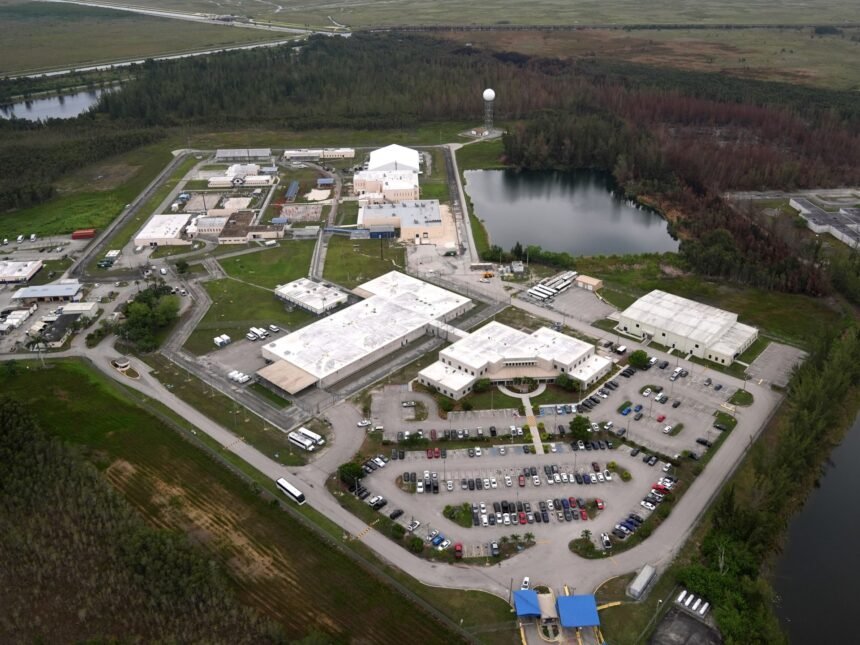Detainees at three United States immigration detention centres have reported degrading situations, together with a delay in medical therapy that could be tied to 2 deaths, in line with a human rights report.
The investigation printed on Monday detailed girls held in male amenities, rampant overcrowding and doubtlessly lethal indifference to medical wants on the three amenities in or close to Miami, Florida: Krome North Service Processing Heart, Broward Transitional Heart and the Federal Detention Heart.
Its authors mentioned the abuses underscore one other side of the human toll of President Donald Trump’s deportation marketing campaign, which has compelled many amenities to function past their capability. In flip, the administration has sought a mad-dash scale-up in deportation infrastructure with new amenities, together with the Florida state-erected “Alligator Alcatraz”, spiking their very own issues and condemnation.
In an announcement accompanying the 92-page report’s launch, Belkis Wille, the affiliate disaster and battle director at Human Rights Watch, which authored the report with Individuals for Immigrant Justice and Sanctuary of the South, warned that “individuals in immigration detention are being handled as lower than human.”
“These usually are not remoted incidents, however slightly the results of a basically damaged detention system that’s rife with severe abuses,” Wille mentioned.
Denial of medical care
The report, which relied on present and former inmate testimony, data from members of the family, attorneys and Immigration and Customs Enforcement (ICE) company information, detailed a lax method to medical care on the three amenities, which included denial of therapy and medicine.
One detainee recounted guards in late April ignoring cries for assist as 44-year-old Marie Ange Blaise, a Haitian nationwide, suffered what would show to be a lethal medical emergency on the Broward Transitional Heart.
“We began yelling for assist, however the guards ignored us,” the detainee recounted, in line with the report. By the point a rescue crew got here greater than half an hour later, “she was not transferring.”
The detainee who detailed the loss of life mentioned she was additionally punished for in search of psychological well being therapy, including individuals had been recurrently put in solitary confinement for requesting such assist.

In one other occasion, the spouse of Maksym Chernyak, a 44-year-old Ukrainian man, mentioned her husband’s requests in February to see a physician had been repeatedly delayed as he skilled fever, chest ache and different signs whereas in detention at Krome. When he did see a physician, he was recognized with elevated blood strain, which was circuitously handled, in line with his spouse.
When Chernyak later began vomiting, drooling and defecating on himself, a cellmate recounted that guards took 15 to twenty minutes to reply. After they did, they accused Chernyak of taking illicit artificial medicine, a declare the cellmate, recognized solely as Carlos, denied.
Chernyak was eliminated on a stretcher, declared mind useless and pronounced useless two days later.
Overcrowding and degrading behaviour
Throughout the three amenities, the report detailed rampant overcrowding with detainees at Krome saying they had been held in cells that at instances exceeded twice their capability.
The crowding led to shortages in bedding, cleaning soap and different sanitation merchandise, and a few detainees had been compelled to sleep on the ground.
Ladies had been additionally processed at Krome regardless of it being a male-only facility. Ladies held on the centre informed the investigators that they had been denied showers and compelled to make use of open bogs doubtlessly seen to the male inhabitants.
“If the lads stood on a chair, they might see proper into our room and the bathroom,” recounted a lady from Argentina. “We begged to be allowed to bathe, however they mentioned it wasn’t attainable as a result of it was a male-only facility.”
Different alleged abuses embrace extreme use of power, insufficient entry to meals, extended shackling and publicity to excessive warmth and chilly. Detainees reported 30 to 40 individuals crowded right into a room meant for six and being compelled to make use of a bucket as a rest room.
Harpinder Chauhan, a British entrepreneur who spent months bouncing between amenities after being detained by ICE at an everyday immigration appointment in February, recounted one response from detention centre authorities.
“They informed us if we saved asking for a bathroom that flushed, they might create an issue we wouldn’t like,” he mentioned.
Violations of worldwide, home legislation
All informed, the report’s authors mentioned the allegations quantity to violations of each worldwide legislation and federal US insurance policies on immigration detention.
They mentioned the situations confirmed the fallout of Trump’s effort to enact mass deportations – a drive itself predicated on the evidenceless declare that immigrant criminality is rampant within the US – regardless of missing the correct sources.
The variety of individuals held in immigration detention, who’re sometimes present process their proper to problem their deportations, has risen steadily since Trump took workplace on January 20, leaping from 39,238 on January 26 to 56,816 on July 13, in line with information compiled by the Transactional Data Entry Clearinghouse.
On Saturday, The Wall Road Journal reported the Trump administration is in search of to shortly scale up its detention capability from 40,000 to 100,000 beds by 12 months finish, largely by prioritising quick-build tent amenities on army bases and ICE properties.
The development drive comes after Trump signed a tax and spending invoice that surges an unprecedented $45bn to new detention centres.
Final week, US Homeland Safety Secretary Kristi Noem mentioned the administration would additionally search to spice up cooperation with states like Florida to open extra detention amenities like “Alligator Alcatraz”, whose building is initially funded not by the federal authorities however by state taxpayers.
